| Pages:
1
2 |
cal
Hazard to Self
 
Posts: 88
Registered: 7-2-2012
Member Is Offline
Mood: No Mood
|
|
Phosphorus Pentachloride
I recently obtained 1 kilo of calcium phosphide Ca3P2 at a cost to cheap to pass up. I will be attempting the Leonid Lerner Small Scale Synthesis of
Phosphorus Pentachloride from calcium phosphide and chlorine at 240 degrees C.
Has anyone here done this reaction? 
|
|
|
UnintentionalChaos
International Hazard
    
Posts: 1454
Registered: 9-12-2006
Location: Mars
Member Is Offline
Mood: Nucleophilic
|
|
Presumably Leonid Lerner has, as he is a member here.
Department of Redundancy Department - Now with paperwork!
'In organic synthesis, we call decomposition products "crap", however this is not a IUPAC approved nomenclature.' -Nicodem
|
|
|
cal
Hazard to Self
 
Posts: 88
Registered: 7-2-2012
Member Is Offline
Mood: No Mood
|
|
Leonid Lerner
I did a search and did not find a member under Leonid Lerner.
Maybe he uses a different name here.
|
|
|
Mailinmypocket
International Hazard
    
Posts: 1351
Registered: 12-5-2011
Member Is Offline
Mood: No Mood
|
|
He does. It is Len1 I believe
|
|
|
SM2
Hazard to Others
  
Posts: 359
Registered: 8-5-2012
Location: the Irish Springs
Member Is Offline
Mood: Affect
|
|
Careful what you do w/ that PCL5.....or it will Learn you a new lesson. BTW: why on Earth would you be messing with such an infamous and nasty
chlorinater? take care, >leaving> now.
|
|
|
kristofvagyok
National Hazard
   
Posts: 659
Registered: 6-4-2012
Location: Europe
Member Is Offline
Mood: No Mood
|
|
Even working with PCl5 is a really-really bad thing, to prepare it at home could be a nightmare.
I remember when I first worked with PCl5 I used a nearly 10 year old sample what was opened once before me. It was in a large glass bottle, made by
Fluka (contained 1 kilo) and when I opened, it just blown down the cap. When it was opened long ago, a little water had been absorbed and it generated
a lot HCl, POCl3 during the time, so it became overpressured... Be careful 
I have a blog where I post my pictures from my work: http://labphoto.tumblr.com/
-Pictures from chemistry, check it out(:
"You can’t become a chemist and expect to live forever." |
|
|
Magpie
lab constructor
    
Posts: 5939
Registered: 1-11-2003
Location: USA
Member Is Offline
Mood: Chemistry: the subtle science.
|
|
I'm puzzled by this statement. I have not worked with PCl5 but have used PCl3 - back in my introductory organic class at a university in 1962. It
was kept in a reagent bottle with a ground glass stopper in the lab hood. We used it to make acetyl chloride as one of our assigned experiments. I
do remember the instructor (a busy PhD grad student) telling us to only open the bottle in the hood.
[Edited on 18-11-2012 by Magpie]
The single most important condition for a successful synthesis is good mixing - Nicodem
|
|
|
woelen
Super Administrator
        
Posts: 7977
Registered: 20-8-2005
Location: Netherlands
Member Is Offline
Mood: interested
|
|
PCl5 is a very nasty chemical and it is hard, really hard, to store this material. I have a small sample of the material and it really eats every cap.
Even the beautiful red GL45 caps with teflon liner are eaten slowly and become soft over time.
Even bromine is a toy when compared to PCl5 when it comes to storage!
Als be very careful with the phosphide. With water it releases PH3, which is extremely toxic and this reaction also occurs, even when some water vapor
comes into the bottle of the phosphide.
How do you think you are going to make PCl5? Passing chlorine over the phosphide?
[Edited on 18-11-12 by woelen]
|
|
|
stoichiometric_steve
National Hazard
   
Posts: 819
Registered: 14-12-2005
Member Is Offline
Mood: satyric
|
|
you should absolutely buy my mag stirrer before you die.
|
|
|
DJF90
International Hazard
    
Posts: 2266
Registered: 15-12-2007
Location: At the bench
Member Is Offline
Mood: No Mood
|
|
LOL now thats salesmanship 
|
|
|
SM2
Hazard to Others
  
Posts: 359
Registered: 8-5-2012
Location: the Irish Springs
Member Is Offline
Mood: Affect
|
|
Quote: Originally posted by woelen  | PCl5 is a very nasty chemical and it is hard, really hard, to store this material. I have a small sample of the material and it really eats every cap.
Even the beautiful red GL45 caps with teflon liner are eaten slowly and become soft over time.
Even bromine is a toy when compared to PCl5 when it comes to storage!
Als be very careful with the phosphide. With water it releases PH3, which is extremely toxic and this reaction also occurs, even when some water vapor
comes into the bottle of the phosphide.
How do you think you are going to make PCl5? Passing chlorine over the phosphide?
[Edited on 18-11-12 by woelen] |
woelen, that's amazing that it will attack even polytef. Perhaps the PCL5 can fit between the chain of polytef molecules. My first intuition would
tell me no, but if it's just thin (membrane) polytef, maybe that is different. How about a quartz bottle with a ground quartz stopper? I think this
chemist would be much safer making his PCL5 from the PCL3 +Cl in situ.
|
|
|
Endimion17
International Hazard
    
Posts: 1468
Registered: 17-7-2011
Location: shores of a solar sea
Member Is Offline
Mood: speeding through time at the rate of 1 second per second
|
|
No stoppers, no nothing. Glass seals. End of discussion.
People, learn to make ampoules or you will be taught about the danger the hard way.
|
|
|
Dr.Bob
International Hazard
    
Posts: 2659
Registered: 26-1-2011
Location: USA - NC
Member Is Offline
Mood: No Mood
|
|
While Teflon is only attacked by a few chemicals, some molecules can diffuse into and through teflon and other fluoropolymers, like other halogens.
DCM and TFA both have a slow permeation through teflon as well. That is why Teflon stirbars can turn colored or dark, many material can absorb into
the Teflon and get trapped there. It does not mean that they have destroyed the teflon, only been absorbed into it. That can soften it, as Woelen
stated. Silicone (and Viton to a lesser extent) cap liners are even worse, many solvents swell them unmercifully, even though the silicone may not
dissolve, but the liner is damaged over time by the swelling.
|
|
|
Magpie
lab constructor
    
Posts: 5939
Registered: 1-11-2003
Location: USA
Member Is Offline
Mood: Chemistry: the subtle science.
|
|
In theory I have produced 13.4g of PCl5 using the method of garage chemist. I dissolved 2g of P in 100mL of chloroform then sparged it with dry Cl2.
The key to this technique is the plunger used to keep the sparge tube end from plugging with PCL5, a white solid.
Originally I tried to do this with a ptfe plunger rod but it was too weak and would break. I then tried to make a heated sparge tube to keep the PCl5
a liquid but I could not make a tube that did not break. This latest version employs a 3/32" ss316 welding wire. This worked well. It is, however,
subject to some corrosion giving the solvent a yellow color. Dissolved Cl2 also contributes to this color. Next time I will try an AWG 12 copper
wire. The wire is sealed using a gland made of an inverted rubber septum, size 19/22.
Krytox grease was used for all tapered glass joints. This really works well and no hard, sticky white residue was formed. Just a thin layer is
needed. I must thank U. Chaos for his suggestion to use this with Cl2.
Tommorrow I will continue with the workup to isolate and weigh the PCl5. I'm thinking storage in an ampule may be best after reading the above posts.
-------------------------------------------------------------
Overnight most all of the dissolved Cl2 outgassed from the solvent as the solvent is almost clear now. Apparently there was very little FeCl3 if any.
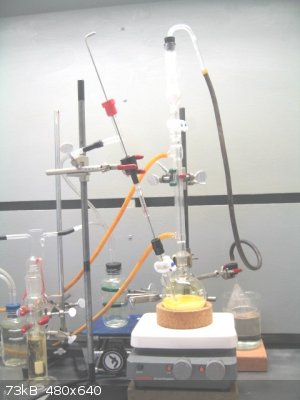
PCl5 apparatus
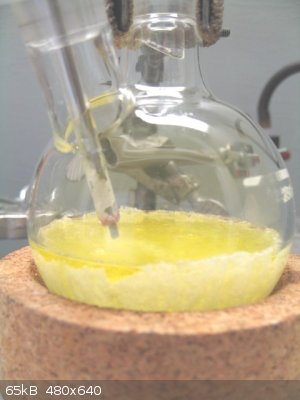
PCl5 in chloroform
[Edited on 9-8-2015 by Magpie]
[Edited on 10-8-2015 by Magpie]
The single most important condition for a successful synthesis is good mixing - Nicodem
|
|
|
Oscilllator
National Hazard
   
Posts: 659
Registered: 8-10-2012
Location: The aqueous layer
Member Is Offline
Mood: No Mood
|
|
Did the phosphorous you used actually dissolve in the chloroform? I would have thought the polymeric structure of red phosphorous would prevent that.
Unless you used white phosphorous 
I also noticed that the picture on the wiki page of PCl5 was taken by woelen. It seems he has contributed pictures of just about every chemical under
the sun!
|
|
|
Magpie
lab constructor
    
Posts: 5939
Registered: 1-11-2003
Location: USA
Member Is Offline
Mood: Chemistry: the subtle science.
|
|
I used white P from some I made several years ago. Yes it dissolves at 1g/40mL. Garage chemist used red P.
The reaction was very smooth but does generate significant heat. Hence the reflux condenser.
The single most important condition for a successful synthesis is good mixing - Nicodem
|
|
|
chemrox
International Hazard
    
Posts: 2961
Registered: 18-1-2007
Location: UTM
Member Is Offline
Mood: LaGrangian
|
|
I transferred mine to a Teflon bottle and store that in the fume cupboard .. before I did that I wondered why I was getting acid damage all over the
lab.
"When you let the dumbasses vote you end up with populism followed by autocracy and getting back is a bitch." Plato (sort of)
|
|
|
Magpie
lab constructor
    
Posts: 5939
Registered: 1-11-2003
Location: USA
Member Is Offline
Mood: Chemistry: the subtle science.
|
|
chemrox, so you are saying that PCl5 does not destroy Teflon but that the bottle still leaks? I presume then, that your hood fan is on all the time?
PCl5 + H2O ---> POCl3 + 2HCl
So it seems that ingress of H2O is the root of the storage problems with PCl5. This is true also with storing AlCl3.
2AlCl3 + 3H2O ---> 6HCl + Al2O3
With AlCl3 I had a serious problem (bottle destruction) with what was apparently H2O permeating the plastic bottle and reacting to form HCl.
I store muriatic acid (31% HCl) in a 100mL narrow mouth glass bottle (Qorpak) with a Teflon seal in my lab as a day use bottle. I store the bottle in
a plastic bag with some NaHCO3. This seems to work OK as my carbon steel tools are not rusting (much).
The single most important condition for a successful synthesis is good mixing - Nicodem
|
|
|
Magpie
lab constructor
    
Posts: 5939
Registered: 1-11-2003
Location: USA
Member Is Offline
Mood: Chemistry: the subtle science.
|
|
...continuation of yesterday's post:
The pot with PCl5 and chloroform was set up for simple distillation to remove the chloroform. An oil bath controlled with a PID was used as a heating
source. The chloroform came over at 61°-65°C. There was likely some HCl in the beginning and some CCl4 at the end.
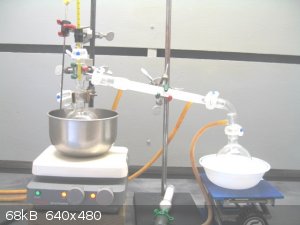
solvent removal from PCl5
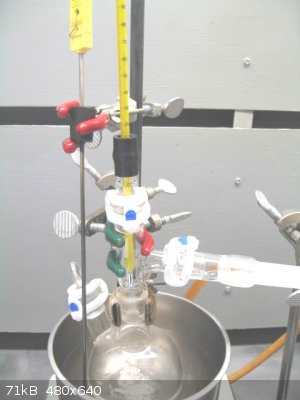
PCl5 precipitating during solvent removal
As garage chemist indicated the PCl5 still contained some solvent even though I had the bath oil up to 110°C. So, I did as he did, ie, subjected the
slush to vacuum distillation at 177mmHg until I saw what likely was sublimation on the RBF walls. 1.2mL of solvent came over.
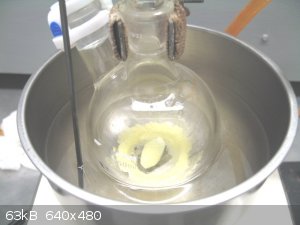
PCl5 (w/stirbar) nearly dried
I then reached in the side-neck with a spatula and broke up the crumbly PCl5. I again subjected it to vacuum distillation at 152mmHg but no more
solvent came over.
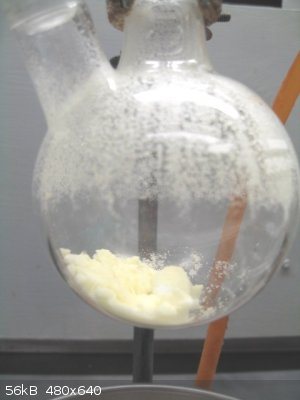
PCl5 vacuum dried
After cooling the powder was transferred to a Qorpak 100mL wide-mouth bottle with ptfe lid seal.
The net weight of PCl5 was 9.1g for an efficiency of 67.7%.
Questions, comments, suggestions are welcomed.
[Edited on 11-8-2015 by Magpie]
[Edited on 11-8-2015 by Magpie]
The single most important condition for a successful synthesis is good mixing - Nicodem
|
|
|
Oscilllator
National Hazard
   
Posts: 659
Registered: 8-10-2012
Location: The aqueous layer
Member Is Offline
Mood: No Mood
|
|
I have a question: Where do you think the remaining 32.4% of the phosphorous went? If the phosphorous remained unreacted, it seems like this could be
very dangerous if the PCl5 contaminated with white phosphorous was exposed to the air, as that would end very badly as I'm sure you can imagine.
Is it possible that you lost a significant amount during the time the PCl5 was under vacuum? Wikipedia lists the boiling point as 160.5° so it seems
likely that some could come over at the 110° temperature of the oil bath.
|
|
|
Magpie
lab constructor
    
Posts: 5939
Registered: 1-11-2003
Location: USA
Member Is Offline
Mood: Chemistry: the subtle science.
|
|
Good question. I know that some of it remains as PCl5 sublimate on the inside of the 250mL RBF. As it was subliming part of it probably went over
into the distillate receiver with the chloroform in which it is highly soluble.
Traces of water would convert it to HCl/POCl3 as suggested by garage chemist.
Tomorrow I plan to make a YouTube video of what happens when water is added to the RBF with the sublimate. If it is interesting I will post it in
this thread.
Your point about the danger of not accounting for all P is well taken. Sometimes it seems like a wild animal waiting in the bushes to pounce on the
unwary chemist. Elemental P is especially dangerous due to its fire hazard.
I have seen no indication that the PCl5 is contaminated with P but I don't see why it couldn't be. Placing some on a watch glass might tell if it
starts smoking. But this might be easy to confuse with the HCl/POCl3 being formed when it reacts with the humidity in the air. Right now I have it
covered with argon in a tightly closed bottle and hesitate to open it.
I saved the recovered chloroform and plan to distill it one day. I could get some surprises there too.
The highest oil bath temperature was indeed 110°C but it takes about a 20° differential to get sufficient heat transfer.
The single most important condition for a successful synthesis is good mixing - Nicodem
|
|
|
Oscilllator
National Hazard
   
Posts: 659
Registered: 8-10-2012
Location: The aqueous layer
Member Is Offline
Mood: No Mood
|
|
Quote: Originally posted by Magpie  | | I have seen no indication that the PCl5 is contaminated with P but I don't see why it couldn't be. Placing some on a watch glass might tell if it
starts smoking. |
A easy way to tell the difference would be to look at this experiment in the dark to watch for white phosphorous' characteristic glow. I haven't
personally experienced this so I don't know how bright it is, but a long exposure photograph should reveal the presence of even small quantities of
the stuff.
|
|
|
Marvin
National Hazard
   
Posts: 995
Registered: 13-10-2002
Member Is Offline
Mood: No Mood
|
|
Wouldn't the reaction have to pass through the trichloride stage before any pentachloride formed?
|
|
|
Magpie
lab constructor
    
Posts: 5939
Registered: 1-11-2003
Location: USA
Member Is Offline
Mood: Chemistry: the subtle science.
|
|
You are probably right Marvin.
Another safety factor is the fact that I used 2X the stoichiometric amount of Cl2. The solvent turned a strong yellow long before I finished gassing.
P reacts very strongly with Cl2. It would be extremely strange to find any elemental P anywhere.
I started this experiment back in April but had to suspend it due to plugging of the sparge tube. So, I just placed the 2-neck RBF containing the P
dissolved in chloroform in a sand bucket then placed this in my tool shed well away from the house. It sat there without popping a stopper all summer
through scorching heat - ambient sometimes over 110°F (43°C)!
When I weighed out the P I wasn't real careful as indicated by the fact I report it with only one significant digit. So I may have used something
less than 2.00g (or something more!). Next time I will weigh it more carefully and look for a better accounting of all the P, ie, a mass balance.
The single most important condition for a successful synthesis is good mixing - Nicodem
|
|
|
Magpie
lab constructor
    
Posts: 5939
Registered: 1-11-2003
Location: USA
Member Is Offline
Mood: Chemistry: the subtle science.
|
|
Here's a video of the sublimated PCl5 reacting with water:
https://youtu.be/ZL8VkLEz1vg
The single most important condition for a successful synthesis is good mixing - Nicodem
|
|
|
| Pages:
1
2 |